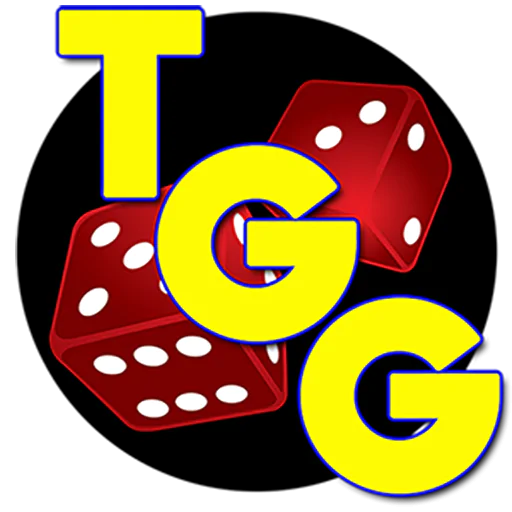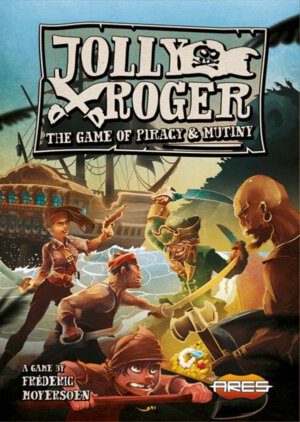
Publisher: Ares Games
Designer: Fréderic Moyersoen
Year: 2015
Genre: Card game of pirating and mutiny
Players: Four to ten players
Ages: 12+
Playing Time: 30-45 minutes
MSRP: $19.99
When I first had a chance to peek at Jolly Roger at this year’s Gen Con I was intrigued. On one hand Ares isn’t exactly a company known for lighter fare or card games and, on the other, there aren’t too many games designed for as many as ten people on the market. It took a while to gather enough gamers to give the title a run for its money but here is the long overdue review of Ares’ first card game.
I’d say it’s rather easy to garner Jolly Roger is about pirates just from the title. Each of the players will represent the crew of the ship. First you’ll appoint a captain and then the captain appoints a quartermaster. Everyone else is the crew.
Set up is simple enough as the various decks (Crew, Destination, and Prize) are sorted. Then the Destination deck is pared down depending on the number of players; these cards have an indicator in the upper right corner to facilitate this. As an example if you saw 8+, and you’re playing with seven people, you would remove that card. Next you’ll sort the Destination Cards into piles of Fort, Merchant Ship, Settlement, Pirate Port, and Treasure Island cards. These are the locations the pirate ship could possibly visit each round.
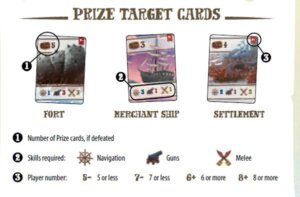
Ten rounds make up a game of Jolly Roger and each round breaks down like this:
Appointment – After the first round the current Captain can appoint a Quartermaster. The Captain doesn’t have to change Quartermasters but they have this option each round. Also if any players have no Crew cards in hand they can draw one at this time.
Voyage – This is the meat and potatoes of Jolly Roger and the Captain chooses a Destination. Three Destinations lead to pirate treasure (Prize cards): Fort, Merchant Ship, and Settlement. The back of the Destination card will indicate approximately what range of values need to be equaled for Navigation, Guns, and Melee to guarantee a successful attack. The Destination card also indicated how many Prize cards will be drawn if the pirates win.
The Quartermaster will play the first Crew card of the attack and then asks all the players around the table to cooperate in order to conquer the target. Each Crew card will indicate the number of crew represented as well as what skills they possess. Some crew members have more than one skill (although only one can be selected for the attack) or even special abilities. Players, including the Captain, don’t have to play cards and can choose to pass. Of course if no one helps out the Voyage will fail. Once the players have finished playing cards to facilitate the attack the Quartermaster flips the Destination card over to see if the attack succeeds.
A successful attack on a Fort, Merchant Ship, or Settlement will allow the Quartermaster to draw the number of Prize cards as indicated by the Destination card and place them face up on the table. Prizes can be Gold (one to three), Jewels, Rum (worth nothing except to recruit more crew at the Pirate Port), and Hostages. The Captain will get the first pick of treasure and then the Quartermaster will hand out Prizes to the players and him/herself. With more players in a game the likelihood of someone not getting treasure increases. With fewer players everyone has to receive a Prize card before anyone else gets a second although it’s still possible some go without.
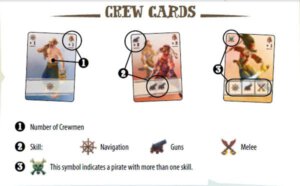
Treasure Island can only be chosen as a Destination if one of the players is willing to play an Old Sailor Crew card as this crewmember possesses a map. Players may only place their Prize cards face down by going to Treasure Island. More on why this is important in a moment. Face down Prize cards are considered buried and cannot be used in the Pirate Port.
Punishment – The Captain can ask the Quartermaster to dish out punishment to one of the players as a way to keep morale up. Personally I think this would have the exact opposite effect but none the less the Quartermaster chooses a player and has that player randomly discard one of their Crew cards. The Captain doesn’t have to have Punishment doled out but the Quartermaster cannot refuse the request.
Of course playing through the phases would be relatively entertaining, if a bit irritating for those not getting treasure, and make for an okay game. Thankfully, this is a pirate game so that means there can be a Mutiny at any time! Or at least at any time after the Captain has made a decision. Any player – outside of the Captain – can call for a Mutiny after the Quartermaster phase, a Destination has been selected, or Punishment issued/not issued.
The mutinying pirate simply calls out “Mutiny” and plays their first Crew card. For mutinies you’ll simply total the crew number is in the upper right of the card to see how many crew are on each side. The player who called for the Mutiny is considered the First Mutineer and the rest of the players will then decide if they will back the Mutineer, the Captain, or stay neutral. Anyone involved in the Mutiny can then continue playing Crew cards until everyone has passed. You can’t change sides once you’ve declared allegiance (although a Traitor card can be played) and once everyone has passed the crew points are totaled for each side. The First Mutineer must exceed the total of the Captain‘s supporters to win and be declared the new Captain.
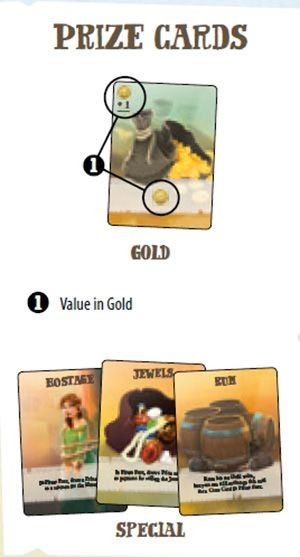
Once a winner has been declared the new, or current Quartermaster depending on the outcome of the Mutiny, will take the unburied Prize cards from the losers of the Mutiny and proceed to pass out loot (even to the losers) in the same manner as they would for a successful attack. The Crew cards which were played during the Mutiny (outside of some special cards like the Cutthroat, Traitor, and Sea Dog) are shuffled and randomly dealt back out to everyone.
Jolly Roger continues until ten Voyages have been completed or the Prize deck runs out. Keep in mind a Mutiny can still be declared following the tenth Voyage too. Everyone will look at all of their Prize cards (buried and unburied) and total up the gold. The value of Jewel and Hostage cards will be determined by randomly drawing Prize cards as usual, unless they’ve run out and, in that case are only worth one gold each. The player with the most gold wins. In the case of a tie then the most gold and rum determines the winner. If there’s still a tie after that then you’ll have to battle it out with cutlasses. Actually, with gold and rum totaling the same then the players tied are co-winners.
While certainly not a game to be played with people who don’t like some conflict and take that happening around the table, I found Jolly Roger to be a good deal of fun. Strangely enough it isn’t the Captain who a player is aiming to take out of command most of the time but the Quartermaster; The Captain isn’t the person screwing players out of Prizes don’t you know. More times than not players have a much bigger bone to pick with the Quartermaster than anyone else.
The game also encourages negotiation with your fellow players and bribes of Prizes and/or Crew cards can come into play.
I can’t say I’d be overly eager to play Jolly Roger with three or four players (there’s a variant for three) but I think the design works very well for six or more. A larger group around the table nearly demands for a free for all and plenty of cries of “Mutiny!” ringing out as there will always be people not getting a fair cut of the loot. As long as everyone approaches the game as a bit of silly fun, and don’t have their feeling hurt easily, you should have a great time hanging with your local seafaring scallywags.
[rwp-review id=”0″]
- Save on the Defiant Urban Fantasy RPG through Bundle of Holding - Apr 28, 2025
- Pathfinder: Thirst for Blood Reviewed - Apr 28, 2025
- The Old Margreve for Tales of the Valiant Reviewed - Apr 27, 2025


















